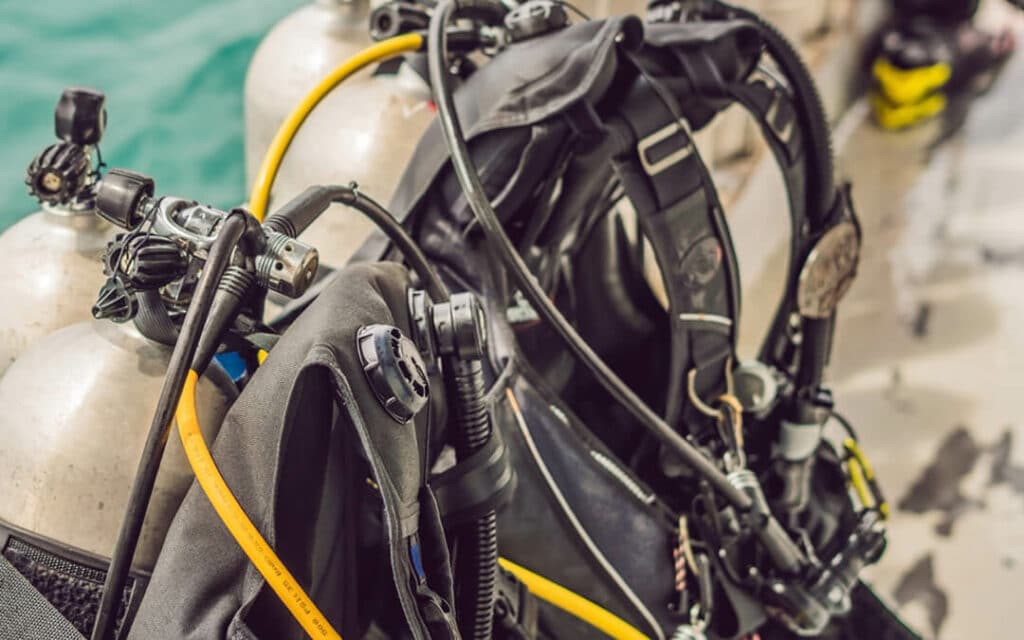This article will cover what a BCD is, the anatomy of a BCD, BCD types and categories, and which one is best for you. Let’s get started!
What does a Scuba BCD Do?
A Buoyancy Control (or Compensator) Device known as a Scuba BCD gives you control above and below the water while using less energy.

Fully inflated, your Scuba BCD allows you to float comfortably at the surface while you wait to get on the dive boat, to surface swim to and from your dive location, or to chat with your dive buddy about where to descend next.
Underwater, your Scuba BCD allows you to adjust the air in your bladder while you kick effortlessly mid-water, observing aquatic life, coral reefs, and even wrecks!.
The BCD also holds your tank or tanks, with some styles having an integrated weight system.
You will learn more about using a BCD underwater to help with buoyancy in the PADI open water course.
Anatomy of a BCD
- Expandable air bladder.
- Adjustable straps and releases.
- Inflator hose.
- Low-pressure inflator connector.
- Power inflator button.
- Manual inflator (oral).
- Deflator and overpressure valves
- Adjustable tank band(s)
- Weight Pockets (Integrated weight system). Optional.
- Integrated Octo/Inflator (Alternate Regulator and Inflator Combo). Optional.
- D-Rings

Scuba BCD Categories
Travel BCDs: Lightweight and easy to pack, these BCDs are designed to make travel less cumbersome. Travel BCDs can be used for everyday diving or just for travel.
Jacket Style BCDs: The most popular for recreational scuba diving as the bladder system inflates around you. A comfortable fit above and below the water, this style usually has more pockets and D-Rings.
Back Inflate BCDs: This BCD has a bladder in the back, unlike the Jacket style where the bladder surrounds you. Once inflated, this BCD makes staying in the water horizontally easier and can feel a little less restrictive.
Hybrid BCDs: A blend between the Jacket and Back Inflate styles.
Tech BCDs: These systems combine wing-style bladders with harness setups to accommodate multiple tanks, D-rings, and pockets.
Sidemount BCDs: These systems combine a back wing and harness that mounts multiple tanks to your sides.
What is the best BCD for you?
To determine the right BCD for you, consider the type of diving you plan to do (i.e., only travel, tech diving, recreational diving, etc.). Then it is all about fit and comfort.
To determine the right fit, you will need to factor in the type of exposure suit you will wear when diving. A drysuit, thick wetsuit, or a rash guard/bathing suit will affect the fit. It is always good to wear the exposure suit when trying on BCDs to ensure it is not too restrictive.
Envision that you are on a dive, orally inflate the BCD to make sure it is still comfortable, and you can tighten and loosen all clips, straps, and releases. Then pull all the dump valve cords and play with the inflator/deflator buttons. Make sure the inflator hose is compatible with your regulator system.
After finding the right brand for fit and comfort, now the fun begins. Pick the one that fits your personality, your colors, and your options!
Remember, your BCD will last for years with the proper care and maintenance. Fit and comfort should be taken into consideration before price.
BCD Maintenance
Remove weights from all weight pockets when not in use.
Always rinse thoroughly with fresh water inside and outside after each use (especially if it comes in contact with chlorine).
Let the BCD dry completely out of direct sunlight if possible.
Partially inflate the BCD and store in a cool and dry place.
Summary
We have just covered BCD information on what a BCD is and which would be the best for you, depending on what type of diving you plan to do. If you have questions about scuba BCDs or which one is right for you, feel free to complete the form below, and we will be happy to point you in the right direction.
